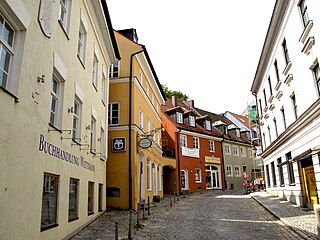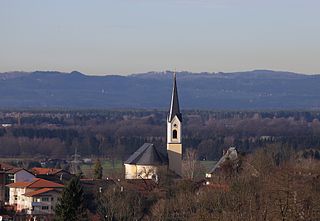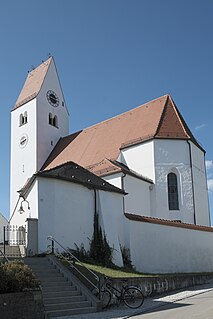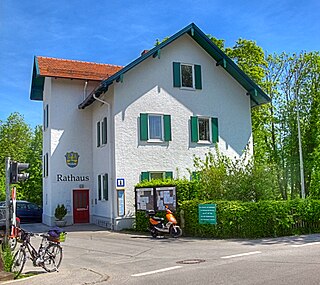Dachau may refer to:

Dachau is a town in Upper Bavaria district of Bavaria, a state in the southern part of Germany. It is a major district town—a Große Kreisstadt—of the administrative region of Upper Bavaria, about 20 kilometres north-west of Munich. It is now a popular residential area for people working in Munich, with roughly 45,000 inhabitants. The historic centre of town with its 18th-century castle is situated on an elevation and visible over a great distance.

Rohrdorf is a municipality in the district of Rosenheim in Upper Bavaria, Germany. It is located in the Inn valley.

Dachau was a Nazi concentration camp opened on 22 March 1933, which was initially intended to hold political prisoners. It is located on the grounds of an abandoned munitions factory northeast of the medieval town of Dachau, about 16 km (10 mi) northwest of Munich in the state of Bavaria, in southern Germany. After its opening by Heinrich Himmler, its purpose was enlarged to include forced labor, and, eventually, the imprisonment of Jews, Romani, German and Austrian criminals, and, finally, foreign nationals from countries that Germany occupied or invaded. The Dachau camp system grew to include nearly 100 sub-camps, which were mostly work camps or Arbeitskommandos, and were located throughout southern Germany and Austria. The main camp was liberated by U.S. forces on 29 April 1945.

Maria Mandl was an Austrian SS-Helferin known for her role in the Holocaust as a top-ranking official at the Auschwitz-Birkenau extermination camp, where she is believed to have been directly complicit in the deaths of over 500,000 female prisoners. She was executed for war crimes.

Richard Baer was a German SS officer who, among other assignments, was the commandant of Auschwitz I concentration camp from May 1944 to February 1945, and right after, from February to April 1945, commandant of Mittelbau-Dora concentration camp. Following the war, Baer lived under an assumed name to avoid prosecution but was recognized and arrested in December 1960. He died in detention before he could stand trial.

Franz Bonaventura Adalbert Maria Herzog von Bayern, commonly known by the courtesy title Duke of Bavaria, is the head of the House of Wittelsbach, the former ruling family of the Kingdom of Bavaria. His great-grandfather King Ludwig III was the last ruling monarch of Bavaria until being deposed in 1918.

Lochau is a municipality in the westernmost Austrian state of Vorarlberg. It is located on Lake Constance, in the Bregenz district, near the border to Germany.

During the Dachau liberation reprisals, German prisoners of war were killed by U.S. soldiers and concentration camp internees at the Dachau concentration camp on April 29, 1945, during World War II. It is unclear how many SS members were killed in the incident but most estimates place the number killed at around 35–50. In the days before the camp's liberation, SS guards at the camp had forced 7,000 inmates on a death march that resulted in the death of many from exposure and shooting. When Allied soldiers liberated Dachau, they were variously shocked, horrified, disturbed, and angered at finding the massed corpses of internees, and by the combativeness of some of the remaining guards who allegedly fired on them.

The Dachau trials were held for all war criminals caught in the United States zones in occupied Germany and Austria, as well as for those individuals accused of committing war crimes against American citizens and its military personnel. The trials, which were held within the walls of the former Dachau concentration camp, were conducted entirely by American military personnel whose legal authority had been conferred by the Judge Advocate General's Department within the U.S. Third Army. The Dachau camp was established on 10 March 1933 in the town of Dachau, roughly 12 miles north of Munich, and was liberated on 29 April 1945. The Dachau trials were held at Dachau Concentration Camp due to the camp having the facilities to hold the trials, and also because many of those prisoners who had worked there were confined to the premises.

Paul Giesler was a German Nazi Party functionary responsible for acts of brutality which included killing opponents of the regime in southern Germany. He first joined the Nazi Party (NSDAP) in 1922; he reenrolled on 1 January 1928 with Party number 72,741. From 1941 he was Gauleiter of Westphalia-South (Westfalen-Süd) and in 1942 was appointed to the position for the Gau Munich-Upper Bavaria. From 2 November 1942 to 28 April 1945 he was also Minister-President (Ministerpräsident) of Bavaria.

Allach porcelain a.k.a. Porzellan Manufaktur Allach was produced in Germany between 1935 and 1945. After its first year of operation, the enterprise was run by the SS with forced labor provided by the Dachau concentration camp. The emphasis was on decorative ceramics —objets d'art for the Nazi regime. The company logo included stylized SS runes. Sometimes in place of the company name, the pottery markings mentioned the SS: "DES - WIRTSCHAFTS - VERWALTUNGSHAUPTAMTES".

Oberschleißheim is a municipality in the district of Munich, in Bavaria, Germany. It is located 13 km north of Munich (centre). As of 2005 it had a population of 11,467.

Hurlach is a municipality in the district of Landsberg in Bavaria in Germany.

Utting am Ammersee is a municipality in the district of Landsberg in Bavaria in Germany.

Mühldorf was a satellite system of the Dachau concentration camp located near Mühldorf in Bavaria, established in mid-1944 and run by the Schutzstaffel (SS). The camps were established to provide labor for an underground installation for the production of the Messerschmitt 262 (Me-262), a jet fighter designed to challenge Allied air superiority over Germany.

The Postenpflicht was a general order issued to SS-Totenkopfverbände guards in Nazi concentration camps to summarily execute insubordinate prisoners. The order required guards to shoot prisoners who engaged in resistance or escape attempts, without warning; failing to do so would result in dismissal or arrest. The Postenpflicht was originally issued on October 1, 1933, for guards at Dachau concentration camp, but was later extended to other concentration camps.

Agfa-Commando is the widely used name for the München-Giesing - Agfa Kamerawerke satellite camp of the Dachau concentration camp. By October 1944, the camp housed about five hundred women. They were used as slave laborers in the Agfa camera factory in München-Giesing, a suburb on the S.W. side of Munich 14 miles (23 km) from the main camp of Dachau. The women assembled ignition timing devices for bombs, artillery ammunition and V-1 and V-2 rockets; they used every opportunity to sabotage the production. In January 1945, citing the lack of food, the prisoners conducted a strike, an unheard-of action in a concentration camp. Production ended on 23 April 1945 and the women marched toward Wolfratshausen, where their commander eventually surrendered to advancing American troops.
The Dachau art colony was an artists' colony located in Dachau, Germany, that flourished from around 1890 until 1914.

Dachau is a 72-page investigation report by the 7th US Army on the German Dachau Concentration Camp and the mass murder committed there by the SS and other personnel. The report was prepared immediately after the liberation of the camp by troops of the 7th US Army on 29 April 1945, and was published in a larger edition as early as May 1945. In addition to a preface, the report contains three independent reports which partly overlap thematically. The report is considered one of the first studies on the subject of concentration camps and extermination camps in Nazi Germany. In 2000, the report was republished in an annotated and expanded version by a US publisher.